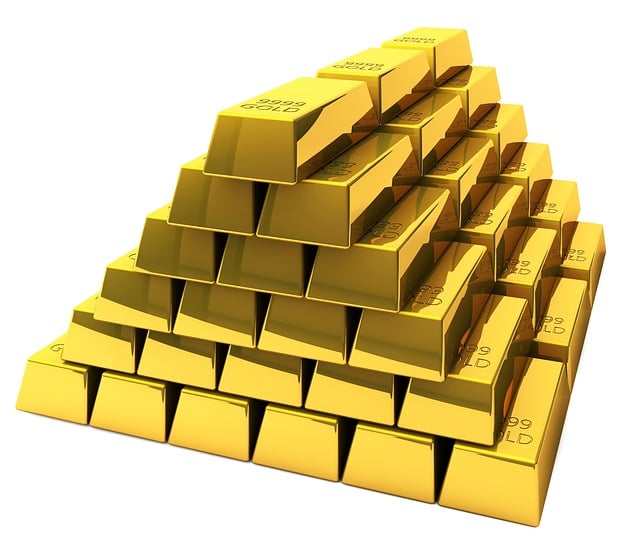
Legacy precious metals serve as a stable and historically reliable component for wealth preservation, offering protection against inflation, economic downturns, and market volatility. These assets—gold, silver, platinum, and palladium—maintain consistent value and are finite with persistent demand, ensuring long-term durability in value. However, it's crucial to consider legacy precious metals fees, which include purchase expenses, storage and insurance costs, and sales taxes, as they can impact the net return on investment. Investors should work with reputable dealers who provide transparent fee structures for informed decision-making.
Legacy precious metals also offer tax advantages, particularly when held within retirement accounts, allowing for deferred capital gains taxes and favorable treatment under tax laws. The fees associated with these investments are typically clear and predictable, contrasting with the complex fee structures of other investment vehicles. Integrating legacy precious metals into estate planning requires careful consideration of all associated costs to maximize their benefits and ensure their value is passed on effectively to heirs.
As a long-term strategy, investing in legacy precious metals can provide portfolio diversification and protect against economic instability. The finite nature of these assets, combined with global demand, often leads to price increases over time. By understanding and planning for the associated fees, investors can leverage the protective advantages of legacy precious metals as part of a wealth accumulation strategy.
Explore the enduring value and strategic role of Legacy Precious Metals in safeguarding and enhancing wealth across generations. This comprehensive guide delves into the historical allure of gold and silver, their unwavering status as timeless assets, and the multifaceted benefits they offer investors. From diversification to tax advantages, learn how incorporating these metals can fortify your financial legacy. We’ll navigate the complexities of including precious metals in estate planning, assess the long-term growth potential, and address inflationary impacts. Understand the nuances of costs and fees associated with Legacy Precious Metals investments, select the ideal metals for your portfolio, and secure their safekeeping. This article also examines legal considerations, market dynamics, and the variety of precious metals available. Gain insights into successful legacy stories, strategic investment approaches, and the psychological comfort of holding tangible wealth in a digital world. Additionally, we’ll discuss global economic trends, environmental impacts, and the process for liquidating your holdings when necessary. With this guide, you’ll be equipped to make informed decisions about building and passing down a precious metals legacy.
- Understanding Legacy Precious Metals and Their Role in Wealth Preservation
- The Historical Significance of Gold and Silver as Stores of Value
- Diversification Benefits of Adding Legacy Precious Metals to Your Portfolio
- Tax Advantages Associated with Investing in Legacy Precious Metals
- The Role of Legacy Precious Metals in Estate Planning
- Long-Term Wealth Growth Potential of Legacy Precious Metals
Understanding Legacy Precious Metals and Their Role in Wealth Preservation

Legacy precious metals represent a time-honored component of wealth preservation strategies. Unlike ephemeral paper assets, these metals—gold, silver, platinum, and palladium—have intrinsic value that often holds its ground against inflation and economic volatility. Owning physical precious metals, particularly in the form of coins or bars, can serve as a hedge against market instability and currency devaluation. The role they play in safeguarding wealth is rooted in their finite supply and consistent demand, which gives them a durable value over time.
Investors turn to legacy precious metals for their longevity and the security they offer. Unlike some investments that rely on performance metrics or managerial decisions, precious metals do not generate income or appreciation based on external factors. Their worth is inherently tied to their physical properties and historical demand. When considering an investment in legacy precious metals, it’s crucial to evaluate the associated fees. These can include purchase costs, storage charges, insurance, and potential sales taxes, all of which can impact the overall return on investment. Transparent fee structures from reputable dealers ensure that investors can make informed decisions, aligning their wealth preservation goals with the enduring value offered by legacy precious metals.
The Historical Significance of Gold and Silver as Stores of Value

Throughout history, gold and silver have consistently served as reliable stores of value, transcending cultural and temporal boundaries. These precious metals have been ingrained in human civilization for millennia, not only as symbols of wealth but also as a hedge against economic uncertainty. Gold, often revered for its lustrous brilliance and purity, has been central to monetary systems across various empires and nations. From the gold standard to modern investment strategies, it remains a prudent component of a diversified portfolio, offering a tangible asset that can preserve purchasing power during inflationary periods. Similarly, silver has held significant value, both for its utility in industry and coinage, and as a medium of exchange. Its role in technology and medicine underscores its enduring importance. Legacy precious metals fees encompass the costs associated with acquiring, storing, and potentially liquidating these assets. Understanding these fees is crucial for investors aiming to integrate gold and silver into their legacy planning effectively, ensuring that the historical significance of these metals as stores of value is preserved for future generations.
Diversification Benefits of Adding Legacy Precious Metals to Your Portfolio

Incorporating Legacy Precious Metals into your investment portfolio can offer significant diversification benefits, particularly in times of economic uncertainty. These assets, which include gold, silver, platinum, and palladium, have historically low correlations with traditional financial markets. This means they often behave differently than stocks or bonds, providing a buffer against market volatility. For instance, when equity markets are underperforming due to various factors such as inflationary pressures, geopolitical tensions, or recessionary fears, precious metals can act as a safe haven, preserving wealth and potentially even increasing in value. The diversification benefits of Legacy Precious Metals extend beyond just market stability; they also contribute to risk management within your portfolio. By adding these tangible assets, investors can reduce their overall portfolio risk profile, as the performance of precious metals is not directly tied to the fate of any single economy or financial instrument.
Furthermore, when considering the addition of Legacy Precious Metals to your investment strategy, it’s crucial to evaluate the associated fees. Unlike mutual funds or ETFs that can have high management expense ratios, physical precious metals often come with a different set of costs, primarily including storage fees and purchase premiums over the spot price. However, these fees can be managed effectively by choosing reputable dealers who offer competitive rates and secure storage solutions. By understanding and comparing the Legacy Precious Metals fees across various providers, investors can optimize their investments to maximize returns while minimizing expenses. This careful consideration of costs is essential in ensuring that the benefits of adding precious metals to your portfolio are fully realized.
Tax Advantages Associated with Investing in Legacy Precious Metals

When considering the realm of investment, legacy precious metals emerge as a prudent choice offering distinct tax advantages that are often favorable compared to other asset classes. Unlike paper assets that can be subject to capital gains taxes upon sale, investments in IRS-approved precious metals such as gold, silver, platinum, and palladium held within a self-directed IRA or other retirement accounts can defer these taxes until distribution—or potentially not at all if the metals are held post-age 72. This tax deferment strategy can significantly enhance the growth potential of your investment portfolio, allowing your assets to compound without the erosive effect of ongoing capital gains taxes.
Moreover, legacy precious metals are exempt from the rustbucket rules that affect collectibles like rare coins or certain artifacts. This exemption means that if you own these metals outside of a tax-advantaged account, they are subject to lower capital gains rates upon sale, providing a more favorable tax treatment than many other investment vehicles. The fees associated with holding and transacting in legacy precious metals are often transparent and predictable, contrasting with the opaque fee structures of managed funds or brokerage accounts. This transparency ensures that investors can better manage and plan for their financial future, making legacy precious metals a strategic component of a diversified investment portfolio.
The Role of Legacy Precious Metals in Estate Planning

Legacy precious metals play a pivotal role in estate planning, offering a tangible and historically resilient asset to pass down through generations. Unlike intangible financial investments that may fluctuate with market conditions, legacy precious metals such as gold, silver, platinum, and palladium maintain intrinsic value over time. This stability makes them an attractive component of a diversified estate portfolio, capable of preserving wealth across economic cycles. Incorporating these assets into your estate plan can provide numerous benefits, including the assurance that a portion of your legacy will be preserved in a form that is both universally recognized and liquid.
When considering the integration of legacy precious metals within an estate plan, it’s crucial to understand the associated fees. These can encompass acquisition costs, storage expenses, insurance premiums, and potential taxes upon inheritance. A comprehensive approach involves careful planning and consultation with legal and financial experts who specialize in legacy asset management. By doing so, you can minimize fees and ensure that the maximum value of your precious metals is passed on to your heirs. Proper management also includes maintaining accurate records and choosing reputable custodians who adhere to industry standards for security and transparency. This attention to detail safeguards the integrity of your legacy and ensures that your precious metals fulfill their intended role in your estate plan.
Long-Term Wealth Growth Potential of Legacy Precious Metals

Legacy precious metals offer investors a traditional and time-honored method to diversify their investment portfolios, with a focus on long-term wealth growth. Unlike paper assets, which can be subject to inflationary pressures and market volatility, legacy precious metals such as gold, silver, platinum, and palladium have historically maintained their value over centuries. Investors often turn to these metals as a hedge against economic uncertainty and currency devaluation. The intrinsic value of these metals is not tied to the performance of any single economy or market, which can provide a buffer against inflation and a means to preserve wealth.
Moreover, the growth potential of legacy precious metals is underpinned by their limited supply and increasing global demand. Factors such as industrial uses, technological advancements, and geopolitical events can drive the prices of these metals higher over time. It’s crucial for investors to consider the fees associated with acquiring, storing, and insuring legacy precious metals. A diligent approach involves carefully evaluating the costs involved, as these can impact the net return on investment. By selecting a reputable provider that offers competitive legacy precious metals fees and transparent transaction processes, investors can optimize their wealth growth strategy while leveraging the protective benefits of these enduring assets.
Legacy precious metals offer a time-honored strategy for wealth preservation and diversification. Their historical significance as immutable stores of value is unparalleled, providing investors with a tangible asset that can complement and hedge against the volatility of other investment classes. The tax advantages associated with these metals further enhance their appeal, making them an attractive component of a well-rounded financial plan. Moreover, their role in estate planning ensures continuity of wealth across generations. As an enduring investment, legacy precious metals can contribute to long-term wealth growth, offering security and potential for appreciating assets. Investors should consider the advantages presented by these metals, particularly mindful of the fees involved in acquiring and holding them, to make informed decisions that align with their financial objectives.







